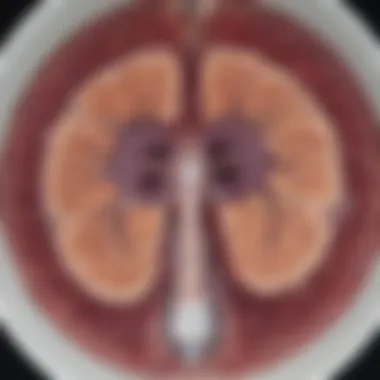CT Scan for Breast Cancer Metastasis: Imaging Insights


Intro
Breast cancer metastasis presents significant challenges in oncology. Understanding how cancer spreads and the role of imaging techniques, like CT scans, is critical for effective treatment and management. The importance of advanced imaging cannot be overstated, as it assists in not just detecting metastasis but also in guiding treatment strategies.
CT scans are a cornerstone in the diagnostic arsenal for healthcare professionals. They provide detailed cross-sectional images that reveal the extent of cancer spread. With the rising incidence of breast cancer worldwide, a focus on the methodologies employed in scanning, their implications in prognosis, and their relevance in clinical settings is necessary.
Through a detailed review of various studies and existing literature, this article aims to elucidate the key findings and methodological approaches concerning the use of CT scans in identifying breast cancer metastasis.
Preface to Breast Cancer and Metastasis
Breast cancer is one of the most commonly diagnosed cancers among women. Its complexity lies not only in the disease itself but also in how it spreads, or metastasizes, to other organs. Understanding the interplay between breast cancer and metastasis is critical in managing the disease effectively. Early recognition of metastasis can significantly influence treatment approaches and patient outcomes, making the imaging techniques used for detection, such as CT scans, essential for oncologists and radiologists alike.
Overview of Breast Cancer
Breast cancer originates in the cells of the breast, often in the ducts or lobules. Factors such as genetics, environmental triggers, and lifestyle choices can contribute to its development. According to the National Cancer Institute, hormonal imbalances and mutations in genes, like BRCA1 and BRCA2, are notable risk factors. The classification of breast cancer is increasingly nuanced, encompassing various subtypes that require specific treatment strategies. Understanding these variations is essential to develop a tailored approach for each patient, improving their likelihood of successful treatment.
Understanding Metastasis
Metastasis refers to the process by which cancer cells spread from the primary site to distant parts of the body. In breast cancer, the most common sites of metastasis include the bones, liver, lungs, and brain. The process involves several steps, including detachment from the original tumor, invasion into nearby tissue, entry into the bloodstream or lymphatic system, and colonization of new sites. Understanding this mechanism is fundamental for designing treatment strategies and for the evaluation of imaging techniques aimed at early detection of metastatic disease.
Significance of Early Detection
Detecting metastasis at an early stage markedly improves treatment outcomes. When cancer is localized, treatment options such as surgery, radiation therapy, and systemic therapies can lead to significantly better survival rates. In contrast, late-stage metastasis often results in a more aggressive disease state and less effective treatment options. Imaging plays a pivotal role in this context. Techniques like CT scans serve not only for initial diagnosis but also for monitoring treatment efficacy and assessing disease progression. Early intervention can ultimately change the trajectory of the disease, highlighting the critical nature of effective imaging methods.
"Understanding the process of breast cancer metastasis and the methods for its detection is crucial in improving patient care and survival rates."
In summary, the interplay of breast cancer and its metastatic behavior necessitates an in-depth understanding of the disease and the technologies that aid its detection. By focusing on imaging techniques like CT scans, we can better address the challenges posed by this complex condition.
Diagnostic Imaging in Oncology
Role of Imaging in Cancer Diagnosis
Imaging plays a crucial role in the diagnosis of cancer. It allows healthcare professionals to visualize internal structures and assess abnormalities. In oncology, accurate imaging can lead to timely and effective treatment decisions. Detecting the presence of tumors, lymph node involvement, and metastasis is vital for staging cancer. The implications of imaging go beyond mere identification; they help in planning surgery and monitoring treatment progress. Therefore, the role of imaging cannot be overstated, as it forms the backbone of modern oncological practice.
Types of Imaging Modalities
A variety of imaging modalities are utilized in oncology to aid diagnosis. These include:
- Computed Tomography (CT): Provides detailed cross-sectional images. It is particularly effective in evaluating soft tissue.
- Magnetic Resonance Imaging (MRI): Offers high-contrast images without using radiation. Particularly useful for brain tumors and assessing soft tissues.
- Mammography: Specifically designed for breast cancer screening. It can detect small tumors that might not be palpable.
- Ultrasound: Utilizes sound waves to create images. Often employed for examining masses in real-time.
- Positron Emission Tomography (PET): Better at showing metabolic activity rather than structural changes. Commonly used to assess the spread of cancer.
Each modality has its unique strengths and weaknesses. The choice of which to use depends on various factors, such as the type of cancer, its location, and the patient's individual circumstances.
Advantages of CT Imaging
CT imaging has several distinct advantages in oncology. Firstly, it offers speedy imaging, making it suitable for urgent evaluations. Secondly, its high resolution provides detailed anatomy, which helps in distinguishing between benign and malignant lesions. Moreover, it excels in visualizing the size and extent of tumors and lymph node involvement.
CT scans can also assess response to treatment effectively. For example, changes in tumor size can indicate whether a patient is responding favorably to a specific therapy. Furthermore, CT imaging allows for three-dimensional reconstruction of images, enhancing the accuracy of surgical planning.
"CT imaging stands out for its detailed anatomical visualization, enabling clinicians to make informed decisions about cancer management."
CT Scanning Techniques and Protocols


CT scanning plays a crucial role in the diagnosis and management of breast cancer metastasis. This section elucidates the fundamental aspects of CT scanning techniques, their protocols, and their significance in clinical practice. Key details, such as types of scans, protocols followed, and choices regarding settings, all contribute to the efficacy of results. Understanding these components ensures that healthcare professionals can employ CT scans effectively to map the extent of metastasis, facilitating timely intervention and treatment adjustments.
CT Scan Basics
A CT scan, or computed tomography scan, generates detailed images of the body's internal structures. The process involves taking multiple X-ray images from various angles and compiling them into cross-sectional views. This technique enhances visualization of soft tissues, which is vital in identifying cancerous growths and understanding their spread.
The fundamental components of a CT scan include:
- Scanner Types: Different scanner types exist, including multi-slice and spiral CT, which affect image resolution and scanning speed.
- Image Reconstruction: Algorithms are used to reconstruct the data into images of various planes, aiding in the assessment of lymph nodes and other regions.
- Scanning Protocols: These dictate parameters like slice thickness and radiation dosage, tailored to individual patient needs. Adhering to established protocols can lead to consistent and reliable scan results, ensuring clarity in understanding the extent of the disease.
Contrast Agents in CT Imaging
The use of contrast agents in CT imaging significantly enhances the visibility of blood vessels and abnormal tissues. These agents usually contain iodine, which absorbs X-rays better than surrounding tissues, improving the differentiation of structures within the scanned area.
Key considerations regarding contrast agents include:
- Administration Methods: Contrast can be administered intravenously or orally, depending on the diagnostic requirement.
- Allergic Reactions: Although uncommon, some patients may experience allergic reactions to contrast agents. It is essential to pre-screen patients for allergies.
- Timing: The timing of the contrast injection can affect imaging quality. Real-time imaging captures distinct details that can offer insight into metastatic processes.
The integration of contrast agents in CT imaging impacts the interpretation of results, allowing for a more comprehensive assessment of metastasis.
Latest Innovations in CT Technology
Advancements in CT technology have dramatically improved the scanning process. Technological progress includes state-of-the-art imaging techniques, aimed at raising the accuracy of diagnostics while minimizing risks associated with radiation exposure.
Notable innovations include:
- Spectral CT: This technology provides enhanced differentiation of tissue types by utilizing multiple energy levels in the X-ray spectrum.
- Low-Dose CT: Efforts to reduce radiation exposure are seen with low-dose protocols that maintain image quality while safeguarding patient health.
- Automated Systems: AI-driven tools help radiologists by highlighting potential areas of concern, significantly aiding in the diagnostic process.
These developments ensure that CT scans are not only more efficacious but also safer. Keeping abreast of these innovations is critical for practicing professionals who wish to utilize CT imaging optimally in their patient care routines.
Clinical Applications of CT Scans in Metastatic Breast Cancer
CT scans play a crucial role in managing metastatic breast cancer. The precision and detail provided by this imaging technique offer critical information on disease progression. Understanding these clinical applications aids in informed decision-making for treatment plans, ultimately affecting patient outcomes.
Detecting Lymph Node Involvement
Lymph nodes often serve as the first site for breast cancer metastasis. CT imaging provides insightful data that can help determine whether the cancer has spread to nearby lymph nodes. Advanced CT techniques can reveal size, shape, and structural changes in lymph nodes, assisting doctors in decision-making.
- Early Detection: Identifying lymph node involvement facilitates early treatment intervention, leading to better prognosis.
- Staging Cancer: Accurate imaging allows for correct cancer staging, which is essential for tailoring treatment plans.
- Surgical Decisions: The information garnered from CT scans can influence surgical approaches, including lymphadenectomy.
Identifying Distant Metastases
Beyond lymph nodes, breast cancer can spread to more distant organs like the liver, lungs, and bones. CT scans are particularly beneficial in detecting these distant metastases. They provide high-resolution imaging that allows clinicians to see potential spread.
- Comprehensive Assessment: CT imaging offers a thorough view of multiple areas in one session, giving a complete picture of cancer spread.
- Monitoring Progression: Regular CT scans can track how metastatic disease progresses over time, informing adjustments in treatment.
- Guiding Future Therapies: Understanding where and how far cancer has spread allows healthcare providers to select appropriate therapeutic interventions.
Assessing Treatment Efficacy
CT scans are not only used for diagnosis but also for evaluating the effectiveness of ongoing treatment. After a specific regimen, doctors can compare pre- and post-treatment images to assess how well the cancer responds to treatment.
- Evaluating Tumor Response: Changes in tumor size or density in imaging can indicate how effectively a treatment is working.
- Tailoring Future Treatment Plans: If a treatment is not yielding desired results, clinicians can swiftly modify the treatment approach based on CT findings, ensuring more targeted management.
- Longitudinal Studies: By regularly performing CT scans, healthcare providers can gather longitudinal data on treatment effectiveness over time, contributing to evidence-based practices.


Understanding these clinical applications of CT scans in metastatic breast cancer enhances both diagnosis and treatment planning. It tailors interventions to patient needs, allowing for more personalized care in oncology.
Limitations of CT Scanning
CT scanning is an essential tool in the fight against breast cancer metastasis. However, it is crucial to recognize the limitations it holds in order to make informed clinical decisions. Understanding these limitations can aid healthcare professionals in improving diagnostic accuracy and patient care.
Radiation Exposure Concerns
One of the primary limitations of CT scanning is the concern regarding radiation exposure. While the benefits of imaging often outweigh the risks, it is essential to remain vigilant. CT scans can expose patients to significant doses of ionizing radiation, increasing their risk for future cancers. The effective dose for a standard CT scan can vary but generally falls between 5 to 10 mSv.
Healthcare providers must weigh the necessity of each scan against these potential risks. This assessment includes evaluating the clinical indication for imaging and considering if alternative modalities, such as MRI or ultrasound, could provide sufficient information with less exposure. Communication with patients about the risks involved is also essential, ensuring they are aware and can participate in decision-making.
False Positives and Negatives
Unfortunately, CT scans are not without diagnostic inaccuracies. False positives and false negatives can occur, potentially leading to misdiagnosis. A false positive happens when the scan suggests the presence of metastasis where none exists, often leading to unnecessary anxiety and additional biopsies. Conversely, a false negative can occur when the scan fails to detect actual metastatic disease, which is particularly concerning in treatment planning.
Factors contributing to these inaccuracies include the quality of images, the skill of the radiologist interpreting them, and the inherent limitations of CT technology. Awareness of these potential errors can encourage clinicians to use CT results alongside other diagnostic tools, ensuring a comprehensive approach to patient evaluation.
Differentiating Between Tumor Types
Another limitation of CT scans lies in their ability to differentiate between various tumor types. While CT imaging provides valuable anatomical details, it struggles to characterize the cellular and molecular features of tumors. For instance, distinguishing between benign and malignant lesions purely based on CT findings can be challenging. Often, imaging results are inconclusive without further investigation, such as biopsy, which may also complicate treatment planning.
This limitation emphasizes the importance of combining imaging studies with histological evaluations to achieve a broad understanding of the patient's condition. Incorporating multiple imaging modalities or employing techniques like PET scans may also enhance diagnostic accuracy in such cases.
Integration of CT Scans in Multimodal Treatment Plans
The integration of CT scans in multimodal treatment plans is crucial for the comprehensive management of metastatic breast cancer. This section underscores the various advantages and critical considerations involved in incorporating CT imaging into a broader treatment strategy. The primary objective is to optimize patient outcomes through precise data that CT scans provide.
CT scans offer detailed images that help clinicians understand the current state of the disease. By accurately identifying the extent of metastasis, healthcare professionals can devise effective treatment regimens tailored to individual patient needs. The ability to visualize both primary tumors and any metastatic sites allows for a more targeted approach to therapy. This imaging modality plays a invaluable role in treatment decisions, shaping surgical interventions, radiotherapy, and systemic therapies.
Role in Surgical Planning
In surgical planning, CT scans are instrumental in determining the appropriate approach for resection of tumor masses or lymph nodes. A thorough understanding of the tumor's anatomical location is essential for surgeons. The detailed images from CT allow them to assess not only the primary breast tumor but also any localized metastases.
This information is crucial because the presence of distant metastasis can significantly alter the surgical approach. For example, if a CT scan reveals involvement of adjacent structures or organs, a more extensive surgical plan may be necessary. Furthermore, CT imaging aids in evaluating the feasibility of surgery in cases where tumors may have invaded critical areas, including major blood vessels.
Guiding Radiation Therapy
CT scans also serve a vital function in guiding radiation therapy for patients with metastatic breast cancer. Radiation oncologists rely on slices of CT images to define target areas precisely, ensuring that the radiation is delivered accurately to the tumor while sparing healthy surrounding tissue. This precision is especially important when treating metastases in sensitive regions such as the spine or brain.
Additionally, the use of CT imaging helps in the evaluation of tumor response to radiation therapy over time. By comparing sequential scans, oncologists can monitor changes in tumor size and assess the effectiveness of the treatment. Adjustments to therapy can be made based on this objective data, improving the overall management of the disease.
Coordinating Systemic Therapies
CT imaging plays a significant role in coordinating systemic therapies, such as chemotherapy and targeted treatments. It aids oncologists in monitoring a patient's response to treatment by providing clear images that highlight changes in the size or number of tumors. This information is vital for determining the next steps in therapy.
By analyzing the data from CT scans, oncologists can make informed decisions on whether to continue, modify, or switch the therapeutic strategy. The integration of imaging with clinical assessment provides a comprehensive view of the patient's progression and ensures that treatments are aligned with their evolving needs.
With advances in imaging technology, the role of CT scans in multimodal treatment plans continues to grow. As our understanding of breast cancer metastasis improves, incorporating refined imaging techniques into treatment protocols will undoubtedly enhance patient outcomes.
Case Studies: CT Imaging in Action


Case studies serve as practical illustrations of how CT scans can be essential in managing breast cancer metastasis. They provide valuable insights into the effectiveness of imaging techniques in real-life scenarios. By examining individual cases, we can comprehend the diverse applications of CT in clinical practice. This section also sheds light on the benefits and subtle challenges encountered with CT imaging. Furthermore, these examples underline the significance of this technology in understanding patient outcomes and guiding treatment decisions.
Successful Early Detection Cases
The role of CT scans in early detection cannot be overstated. In many instances, timely diagnosis of metastatic breast cancer significantly enhances treatment success. One notable case involved a patient presenting with unusual symptoms, such as persistent pain beyond the breast region. The use of a CT scan revealed metastases to the liver, which were not initially suspected. This early identification allowed the oncology team to initiate targeted therapy sooner than if they had relied solely on traditional imaging methods.
CT imaging has continued to show high sensitivity in discovering abnormalities in lymph nodes and other tissues. Moreover, a recent case highlighted how a CT scan identified previously undetected metastatic sites, including in the spine, thereby influencing the treatment plan. Not only did this prevent further progression, but it also improved the patient’s quality of life. These successful early detection cases illustrate how crucial CT imaging is in oncology and its direct impact on clinical outcomes.
Challenges in Complex Cases
Despite the advancements in CT technology, challenges remain, especially in complex cases. These situations often involve patients with multifocal disease or atypical presentations of metastasis. For instance, there was a case where the CT scan initially indicated no significant findings in a patient known to have breast cancer. However, further evaluations using advanced imaging highlighted small lesions that the CT had missed.
False negatives pose a significant concern, particularly in patients with a prior history of breast cancer. Due to the diverse presentation of metastatic lesions, it can be challenging for radiologists to interpret scans accurately. The overlap of metastatic changes with benign conditions often complicates the diagnostic process. These complexities necessitate an interdisciplinary approach, where oncologists and radiologists collaborate closely to assess imaging results meticulously. Such teamwork not only improves diagnosis but also enhances treatment pathways.
Innovative Use of CT in Research
Research plays a pivotal role in shaping the future of CT imaging in breast cancer management. Innovative uses of CT imaging are increasingly being explored. For instance, studies are investigating the capacity of CT to monitor treatment responses in real-time. This approach involves applying advanced software algorithms to analyze imaging data dynamically.
Recent research has shown promise in integrating CT data with biomarkers to predict treatment outcomes. This kind of research not only broadens our understanding of tumor response to therapies but also holds potential for personalizing treatment plans. Furthermore, utilizing machine learning may enhance the precision of CT scans in identifying metastatic lesions, reducing the risk of missed detections.
In summary, these innovative applications of CT in research have the potential to revolutionize breast cancer diagnostics and management strategies. The collaboration between clinical practice and research will undoubtedly enhance how we deploy imaging techniques in oncology.
Future Directions in CT Imaging for Breast Cancer
The field of imaging continues to evolve, and CT scans for breast cancer metastasis are no exception. Staying abreast of future directions in CT imaging is essential, as these advancements can fundamentally impact how we approach diagnosis, treatment planning, and patient management for metastatic breast cancer.
Advancements in Imaging Technology
Technology is advancing rapidly, and CT imaging is benefiting from these developments. Improved imaging resolution allows for more precise detection of metastasis. Innovations like dual-energy CT provide better contrast resolution, allowing for improved visualization of soft tissues. 3D reconstruction and advanced algorithms assist radiologists in assessing tumor characteristics more accurately. This contributes to more personalized treatment plans based on individual patient needs. The integration of multi-parametric imaging further enhances diagnostic capability, allowing for simultaneous evaluation of various tissue properties.
Potential Role of AI in Imaging
Artificial Intelligence (AI) has the potential to revolutionize CT imaging in oncology. By providing tools for automated detection and interpretation of images, AI can significantly reduce the workload of radiologists. It can enhance accuracy by identifying subtle patterns that might be overlooked by human eyes. For instance, machine learning algorithms can be developed to predict metastatic spread based on initial imaging findings. This predictive ability can assist in early intervention, significantly improving outcomes. Moreover, continuous learning from databases of imaging studies can refine diagnostic accuracy over time.
Enhancing Patient Outcomes through Imaging
The ultimate goal of advancements in imaging is to improve patient outcomes. Enhanced CT imaging can lead to earlier detection of metastases, allowing timely initiation of treatment. More precise imaging techniques can reduce the need for invasive procedures, providing a better patient experience. Furthermore, individualized imaging protocols can minimize unnecessary radiation exposure.
"Advancements in imaging techniques fundamentally alter the landscape of cancer diagnosis and treatment, reinforcing the importance of research and innovation in this field."
As we consider these future directions, it is imperative to continue investing in research and training within the healthcare community. With ongoing advancements, there is hope for improved survival rates and quality of life for patients facing breast cancer.
Finale
The conclusion of this article emphasizes the critical importance of CT scanning in the diagnosis and management of breast cancer metastasis. As the landscape of cancer care continues to evolve, the role that imaging techniques like CT scans play cannot be overstated. With precision, they offer enhanced visibility into the spread of cancer, thus arming clinicians with vital data for treatment plans.
Summary of Key Findings
Throughout this discussion, several key findings have emerged:
- Early Detection: CT scans facilitate the early identification of metastatic lesions, which is paramount for improving patient outcomes. The ability to detect metastasis before clinical symptoms emerge can lead to timely interventions.
- Imaging Techniques: Different CT scanning technologies, including high-resolution and contrast-enhanced methods, have distinct advantages in identifying the extent of disease.
- Integration in Treatment Planning: The information yielded from CT scans is not just diagnostic; it helps inform surgical decisions and the planning of systemic therapies, ensuring holistic patient care.
Implications for Clinical Practice
The implications of these findings are significant. Clinicians are encouraged to incorporate CT imaging as a foundational tool in metastatic breast cancer management. This aids in not only diagnosis but also in monitoring treatment effectiveness over time. Moreover, radiologists must stay updated on advancements in CT technology and techniques, which can enhance the accuracy and precision of imaging interpretations.
Call for Further Research
While the current insights are valuable, there remains a need for further research. Future studies should focus on optimizing imaging protocols and evaluating the role of artificial intelligence in enhancing CT scan interpretations. Investigating how patient-specific factors impact imaging results will also contribute to more personalized care. Ultimately, continuous exploration in this domain is essential to refine our approaches and improve patient outcomes in breast cancer treatment.



